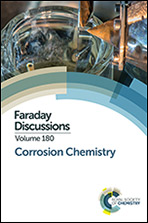Corrosion chemistry closing comments: opportunities in corrosion science facilitated by operando experimental characterization combined with multi-scale computational modelling
Abstract
Recent advances in characterization tools, computational capabilities, and theories have created opportunities for advancement in understanding of solid–fluid interfaces at the nanoscale in corroding metallic systems. The Faraday Discussion on Corrosion Chemistry in 2015 highlighted some of the current needs, gaps and opportunities in corrosion science. Themes were organized into several hierarchical categories that provide an organizational framework for corrosion. Opportunities to develop fundamental physical and chemical data which will enable further progress in thermodynamic and kinetic modelling of corrosion were discussed. These will enable new and better understanding of unit processes that govern corrosion at the nanoscale. Additional topics discussed included scales, films and oxides, fluid–surface and molecular–surface interactions, selected topics in corrosion science and engineering as well as corrosion control. Corrosion science and engineering topics included complex alloy dissolution, local corrosion, and modelling of specific corrosion processes that are made up of collections of temporally and spatially varying unit processes such as oxidation, ion transport, and competitive adsorption. Corrosion control and mitigation topics covered some new insights on coatings and inhibitors. Further advances in operando or in situ experimental characterization strategies at the nanoscale combined with computational modelling will enhance progress in the field, especially if coupling across length and time scales can be achieved incorporating the various phenomena encountered in corrosion. Readers are encouraged to not only to use this ad hoc organizational scheme to guide their immersion into the current opportunities in corrosion chemistry, but also to find value in the information presented in their own ways.
- This article is part of the themed collection: Corrosion Chemistry

 Please wait while we load your content...
Please wait while we load your content...